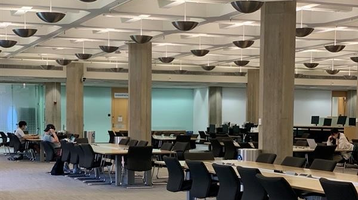Meet new GIS and Maps Librarian Cecilia Smith
Cecilia Smith joined the Library as the GIS and Maps Librarian. Cecilia comes to the University of Chicago from Texas A&M University where she was the Geospatial Librarian, Clinical Assistant Professor at the Evans Library. At Evans Library, Cecilia developed the GIS program, including services, spaces, and support.
Cecilia has an M.A. and Ph.D. in Anthropology from the University of Illinois at Chicago, an M.S. in GIS and Spatial Analysis in Archaeology, with honors, from the University College London and a B.A in Archaeology, Boston University.
Barbara Kern interviewed Cecilia to find out how she plans to work with faculty and students, and what she sees as emerging trends in GIS and Map Libraries.
Cecilia can be reached at ceciliasmith@uchicago.edu, 773-702-8761, Regenstein Library Room 371.
Q: What originally got you interested in Maps?
A: I became interested in maps when I realized how powerful they are—a map can show the shifting boundaries of the Roman Empire, explain the progression of a cholera outbreak, or get you safely home from your hike. They give you the ability to see the world and manage to do it using a single piece of paper.
Q: What originally got you interested in GIS?
A: I learned about geographic information systems (GIS) as an undergraduate researching the development of Mediterranean residences of the Bronze Age. It was a challenge to organize the many variables related to the structures’ location, orientation, and layout. GIS solved my need for a geographic database, and turned out to be so much more. I quickly developed an interest in using the technology to help with spatial analyses and to create visualizations of research results.
Q: How have you worked with faculty at Texas A&M?
A: I worked with faculty at Texas A&M in three ways: collaborating on research, providing consultation on GIS related projects, and sharing resource information with their classes. The Early Modern Shipwreck project (http://modernshipwrecks.com/) is a good example of one of my collaborations with faculty in which I provided geospatial expertise.
Q: How will you work with faculty and students in your role?
A: I will focus on providing services and resources that enable faculty and students to discover, explore, visualize, and curate geospatial information. Geospatial information can take different forms, such as traditional paper maps or GIS files. I will offer consultations and workshops on how to work with different data types.
Q: If you could summarize your PhD research in a few sentences, what would you say?
A: My PhD research focused on changes to indigenous Philippine economies during Spanish colonization. I used GIS technology to analyze archaeological survey and excavation data in the Bacong Municipality of Negros Oriental. I found that the rugged geography of the study area significantly contributed to the indigenous populations’ ability to thrive while Spanish forces focused their resources on more accessible ports.
Q: You previously lived in Chicago. What do you enjoy most about the city?
A: It’s hard to choose just one thing! I love the great food and the lakefront. One of my favorite places is the Lincoln Park Conservatory. I was also a researcher at the Field Museum, so Museum Campus is a favorite, too.



